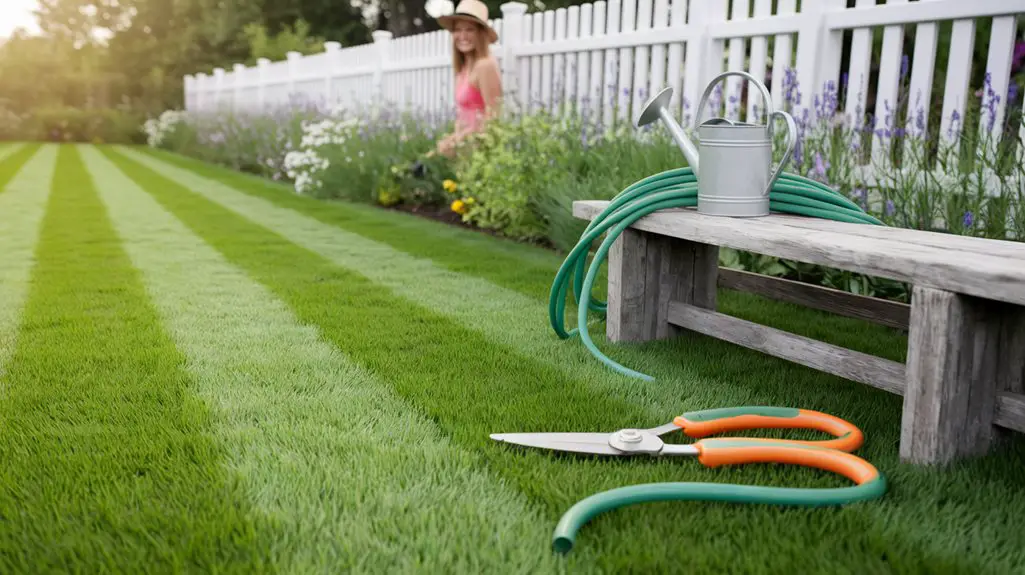When you’re new to lawn care, you’ll find simple techniques create a solid foundation for success. Basic practices teach you critical soil science principles and grass physiology without overwhelming complexity. You’ll discover how proper mowing heights affect root development, how watering frequency influences drought resistance, and how nutrient timing maximizes growth potential. These fundamentals build your technical knowledge while producing visible improvements in your lawn’s health, density, and color. The question remains: which beginner techniques yield the most significant impact?
Benefits of Starting With Basic Lawn Maintenance
Although seemingly trivial, initiating lawn maintenance with fundamental practices offers numerous advantages for novice gardeners.
You’ll establish essential baseline knowledge of soil composition, grass species identification, and seasonal growth patterns without overwhelming complexity. This foundation enables precise diagnostics when problems arise.
Basic maintenance protocols—proper mowing height, consistent watering schedules, and seasonal fertilization—yield measurable improvements while minimizing the risk of chemical misapplication or equipment misuse.
You’ll develop systematic observation skills by monitoring your lawn’s response to these fundamental interventions before implementing advanced techniques.
Additionally, mastering basics creates sustainable habits that optimize resource allocation. Incorporating simple care tips will help ensure your lawn thrives throughout the growing season.
You’ll conserve water through proper irrigation timing and reduce chemical inputs by addressing underlying soil deficiencies first—resulting in cost-effective lawn care with minimal environmental impact.
Essential Tools for Novice Lawn Enthusiasts

Implementing basic lawn care practices requires a foundational set of tools that balance functionality with simplicity. Your initial investment should include a robust lawn mower appropriate for your yard’s square footage, preferably with adjustable cutting heights to maintain the ideal 2.5-3.5 inch grass length.
You’ll need a reliable garden hose with adjustable nozzle for targeted irrigation, and a soil moisture meter to prevent both drought stress and oversaturation. A basic soil pH testing kit allows for science-based amendments rather than speculation.
For maintenance operations, acquire spring-tined rakes for thatch removal, hand pruners for precise trimming, and a broadcast spreader for uniform fertilizer distribution. Additionally, consider incorporating best lawn care tips specifically suited for small backyards to enhance your overall maintenance strategy.
These tools collectively enable execution of fundamental lawn maintenance protocols while providing quantifiable feedback on soil conditions and irrigation effectiveness.
Seasonal Care Routines for Healthy Grass

Maintaining a vibrant lawn requires cyclical adaptation of care protocols that correspond to seasonal metabolic changes in turfgrass species.
You’ll need to implement distinct maintenance regimens for each quarter of the annual cycle.
In spring, apply pre-emergent herbicides when soil temperatures reach 55°F and initiate fertilization with a nitrogen-rich compound (ratio 20-5-10).
Summer demands elevated mowing heights (3-4 inches) to mitigate thermal stress and deep, infrequent irrigation (1-1.5 inches weekly).
Autumn necessitates core aeration when soil compaction exceeds 300 psi, overseeding with appropriate cultivars, and application of potassium-dominant winterizer fertilizer.
Winter protocols involve minimizing traffic on dormant turf and removing debris that may foster pathogenic microorganisms.
Adjust these parameters according to your specific hardiness zone and turfgrass species for ideal physiological response.
Common Mistakes to Avoid When Starting Out
Novice lawn enthusiasts frequently commit several critical errors that compromise turfgrass establishment and vigor. You’ll enhance lawn sustainability by avoiding these fundamental pitfalls. Inappropriate mowing height damages crown tissue, while improper irrigation scheduling induces drought stress or fungal proliferation. Implementing effective lawn care tips can further help in preventing weed growth and maintaining a healthy lawn.
| Error Category | Consequence | Correction Protocol |
|---|---|---|
| Mowing Technique | Scalping/root exposure | Maintain 3-4″ height for cool-season grasses |
| Irrigation Timing | Disease susceptibility | Water before 10:00 AM only |
| Fertilization | Nutrient toxicity/leaching | Apply based on soil test results |
| Thatch Management | Reduced water infiltration | Core aerate annually when grass is actively growing |
Don’t overlook soil compaction assessment, as restricted root zones impede nutrient uptake. Your irrigation efficiency decreases with improper sprinkler calibration, resulting in non-uniform water distribution and consequent drought stress patterns visible during peak temperature periods.
Time-Saving Techniques for Busy Homeowners
Three time-efficient strategies exist for homeowners with limited lawn care availability.
First, implement automated irrigation systems with moisture sensors to optimize watering schedules based on actual soil conditions rather than arbitrary timers. These reduce water consumption by 20-30% while minimizing manual intervention.
Second, practice strategic mowing with the one-third rule: never remove more than one-third of grass blade height during a single mowing session. This approach promotes deeper root development and reduces mowing frequency from weekly to bi-weekly during slower growth periods.
Third, utilize mulching mowers that recycle grass clippings directly into the lawn, eliminating collection time while providing 25% of your lawn’s nitrogen requirements. This technique simultaneously reduces fertilization demands and disposal efforts, creating a self-sustaining nutrient cycle within your turfgrass ecosystem. Additionally, maintaining healthy soil through essential lawn care practices enhances the overall growth of your vegetable garden.
Conclusion
Your initial foray into lawn care benefits greatly from these rudimentary methodologies. You’ll observe quantifiable improvements in turf density and chlorophyll production by implementing these fundamental protocols. Don’t telegraph your inexperience by overcomplicating maintenance regimens; instead, adhere to these evidence-based practices. Remember, even Capability Brown began with simple techniques. By systematically applying these foundational principles, you’re establishing ideal conditions for sustainable lawn development and ecosystem functionality.




